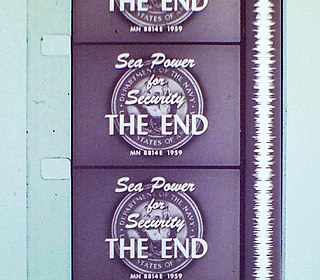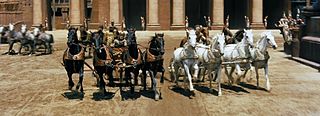
Widescreen images are displayed within a set of aspect ratios used in film, television and computer screens. In film, a widescreen film is any film image with a width-to-height aspect ratio greater than 4:3 (1.33:1).

VistaVision is a higher resolution, widescreen variant of the 35 mm motion picture film format that was created by engineers at Paramount Pictures in 1954.

70 mm film is a wide high-resolution film gauge for motion picture photography, with a negative area nearly 3.5 times as large as the standard 35 mm motion picture film format. As used in cameras, the film is 65 mm (2.6 in) wide. For projection, the original 65 mm film is printed on 70 mm (2.8 in) film. The additional 5 mm contains the four magnetic stripes, holding six tracks of stereophonic sound. Although later 70 mm prints use digital sound encoding, the vast majority of existing and surviving 70 mm prints pre-date this technology.

16 mm film is a historically popular and economical gauge of film. 16 mm refers to the width of the film ; other common film gauges include 8 mm and 35 mm. It is generally used for non-theatrical film-making, or for low-budget motion pictures. It also existed as a popular amateur or home movie-making format for several decades, alongside 8 mm film and later Super 8 film. Eastman Kodak released the first 16 mm "outfit" in 1923, consisting of a Ciné-Kodak camera, Kodascope projector, tripod, screen and splicer, for US$335. RCA-Victor introduced a 16 mm sound movie projector in 1932, and developed an optical sound-on-film 16 mm camera, released in 1935.
IMAX is a proprietary system of high-resolution cameras, film formats, film projectors, and theaters known for having very large screens with a tall aspect ratio and steep stadium seating, with the 1.43:1 ratio format being available only in few selected locations.

CinemaScope is an anamorphic lens series used, from 1953 to 1967, and less often later, for shooting widescreen films that, crucially, could be screened in theatres using existing equipment, albeit with a lens adapter.

Cinerama is a widescreen process that originally projected images simultaneously from three synchronized 35mm projectors onto a huge, deeply curved screen, subtending 146-degrees of arc. The trademarked process was marketed by the Cinerama corporation. It was the first of several novel processes introduced during the 1950s when the movie industry was reacting to competition from television. Cinerama was presented to the public as a theatrical event, with reserved seating and printed programs, and audience members often dressed in their best attire for the evening.
Negative pulldown is the manner in which an image is exposed on a film stock, described by the number of film perforations spanned by an individual frame. It can also describe whether the image captured on the negative is oriented horizontally or vertically. Changing the number of exposed perforations allows a cinematographer to change both the aspect ratio of the image and the size of the area on the film stock that the image occupies.

Todd-AO is an American post-production company founded in 1953 by Mike Todd and Robert Naify, providing sound-related services to the motion picture and television industries. The company retains one facility, in the Los Angeles area.

Panavision Inc. is an American motion picture equipment company founded in 1954 specializing in cameras and lenses, based in Woodland Hills, California. Formed by Robert Gottschalk as a small partnership to create anamorphic projection lenses during the widescreen boom in the 1950s, Panavision expanded its product lines to meet the demands of modern filmmakers. The company introduced its first products in 1954. Originally a provider of CinemaScope accessories, the company's line of anamorphic widescreen lenses soon became the industry leader. In 1972, Panavision helped revolutionize filmmaking with the lightweight Panaflex 35 mm movie camera. The company has introduced other cameras such as the Millennium XL (1999) and the digital video Genesis (2004).

Techniscope or 2-perf is a 35 mm motion picture camera film format introduced by Technicolor Italia in 1960. The Techniscope format uses a two film-perforation negative pulldown per frame, instead of the standard four-perforation frame usually exposed in 35 mm film photography. Techniscope's 2.33:1 aspect ratio is easily enlarged to the 2.39:1 widescreen ratio, because it uses half the amount of 35 mm film stock and standard spherical lenses. Thus, Techniscope release prints are made by anamorphosing, enlarging each frame vertically by a factor of two.

Technirama is a screen process that has been used by some film production houses as an alternative to CinemaScope. It was first used in 1957 but fell into disuse in the mid-1960s. The process was invented by Technicolor and is an anamorphic process with a screen ratio the same as revised CinemaScope (2.35:1), but it is actually 2.25:1 on the negative.
Super Technirama 70 was the marketing name for a special type of deluxe film exhibition that was most popular in the 1960s. It was the 70 mm version of the Technirama exhibition format.

Ultra Panavision 70 and MGM Camera 65 were, from 1957 to 1966, the marketing brands that identified motion pictures photographed with Panavision's anamorphic movie camera lenses on 65 mm film. Ultra Panavision 70 and MGM Camera 65 were shot at 24 frames per second (fps) using anamorphic camera lenses. Ultra Panavision 70 and MGM Camera 65's anamorphic lenses compressed the image 1.25 times, yielding an extremely wide aspect ratio of 2.76:1.

Anamorphic format is the cinematography technique of shooting a widescreen picture on standard 35 mm film or other visual recording media with a non-widescreen native aspect ratio. It also refers to the projection format in which a distorted image is "stretched" by an anamorphic projection lens to recreate the original aspect ratio on the viewing screen.
Panavision has been a manufacturer of cameras for the motion picture industry since the 1950s, beginning with anamorphic widescreen lenses. The lightweight Panaflex is credited with revolutionizing filmmaking. Other influential cameras include the Millennium XL and the digital video Genesis.

The Arri Alexa is a digital motion picture camera system developed by Arri. The Arri Alexa was introduced in April 2010 and was Arri's first major transition into digital cinematography, after previous efforts including the Arriflex D-20 and D-21.












